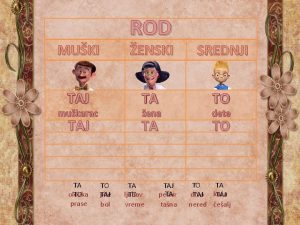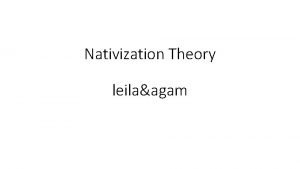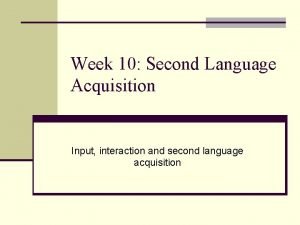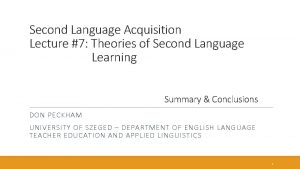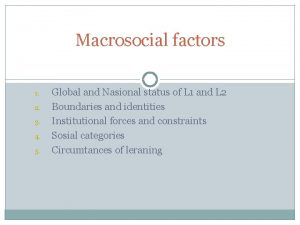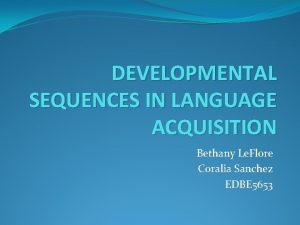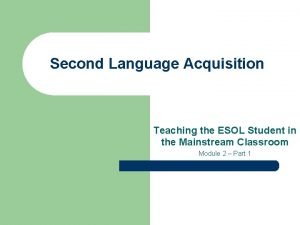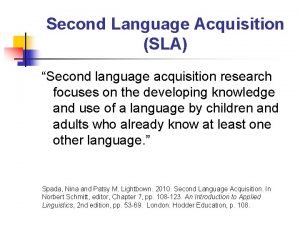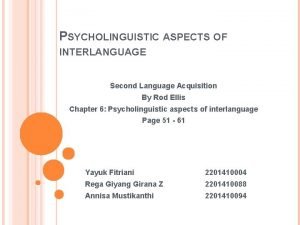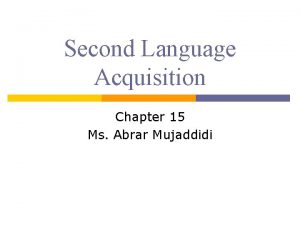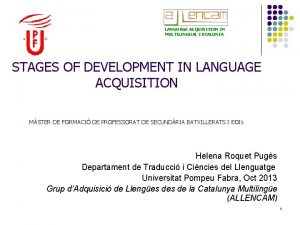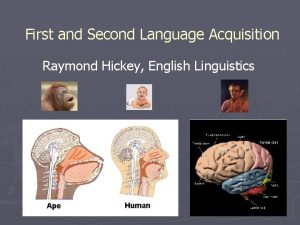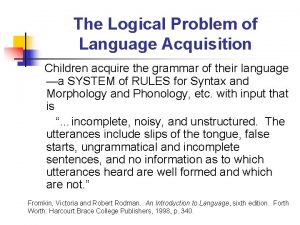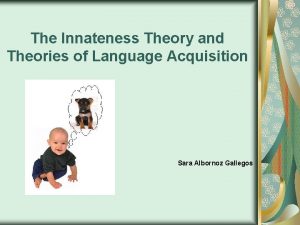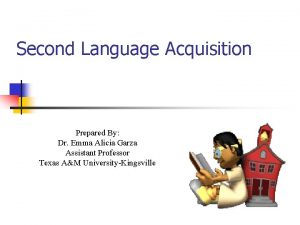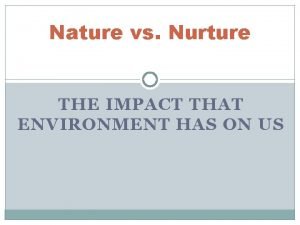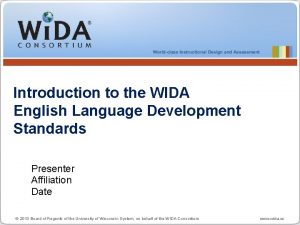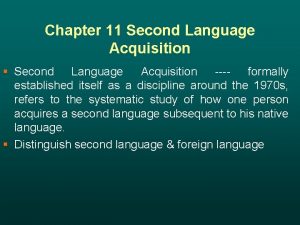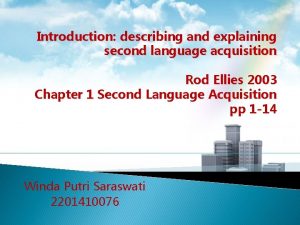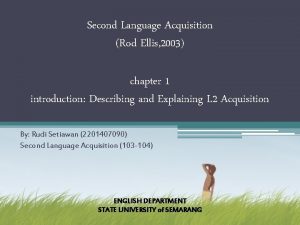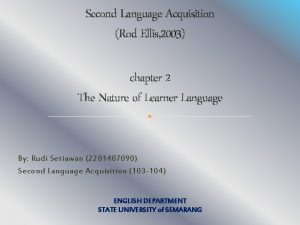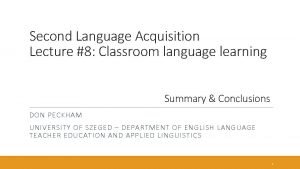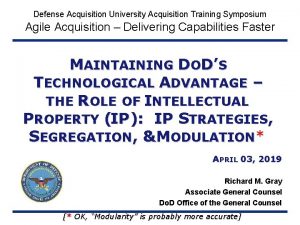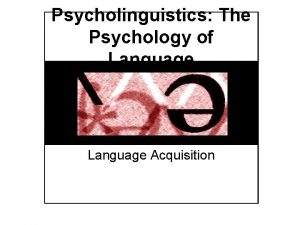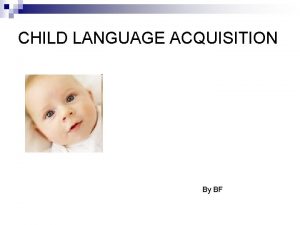Week 11 Second Language Acquisition Language Classroom Rod






























- Slides: 30

Week 11: Second Language Acquisition Language Classroom

Rod Ellis: Principles of instructed language learning • SLA research and theories contribute to how the language should be instructed, or taught. • Some controversies – What approaches? – The efficacy of teaching explicit knowledge – Types of corrective feedback – Etc.

Principle 1: Instruction needs to ensure that learners develop both a rich repertoire of formulaic expressions and a rule-based competence. • Formulaic expressions fluency • A rule-based competence (knowledge of specific grammatical rules) complexity and accuracy • Problem of traditional classroom instruction: Focus on forms – Teaching of specific grammatical rules through the systematic teaching of pre-selected structures – Criticism: rote learning, suitable for young beginner learners

Principle 1: Instruction needs to ensure that learners develop both a rich repertoire of formulaic expressions and a rule-based competence. • Teaching implications – Teach formulaic expressions first – Teach grammar later – Notional-functional syllabus • Focus on functions and pragmatic purposes of the language – – – – Introductions, greetings, good-byes; Invitations, Apologies, Condolences ; Gratitude, Compliments, Congratulations; Requests, Commands, Warnings, Directions ; Offers, Seeking Permission; Advice, Intention ; Pleasure, Displeasure; Expressing your opinion

Principle 2: Instruction needs to ensure that learners focus predominantly on meaning • Two kinds of meaning – Semantic meaning • the meanings of lexical items or of specific grammatical structures – Pragmatic meaning • the highly contextualized meanings that arise in acts of communication

Principle 2: Instruction needs to ensure that learners focus predominantly on meaning • Main focus on pragmatic meaning – Optimal learning condition is created when learners are engaged in decoding and encoding messages in the context of actual acts of communication; – Pragmatic meaning leads to true fluency in an L 2 learners; – Tasks aimed at creating pragmatic meaning is intrinsically motivating.

Principle 3: Instruction needs to ensure that learners also focus on form. • • Conscious attention to form helps acquisition more attention results in more learning Teaching implications 1. Grammar lessons • • Inductive approach (to encourage students to notice pre-selected forms) Deductive approach (to establish an awareness of the grammatical rule)

Principle 3: Instruction needs to ensure that learners also focus on form. 2. Focused tasks • • Comprehension + processing of particular grammatical structures in the input; Production of the structures when performing the task 3. Methodology that induces attention to form • • E. g. the provision of time for strategic and on-line planning and corrective feedback A combination of both intensive and extensive grammar instruction approaches

Principle 4: Instruction needs to be predominantly directed at developing implicit knowledge of the L 2 while not neglecting explicit knowledge. • Implicit knowledge – Procedural i. e. unconscious; verbalizable when made explicit; accessed rapidly and easily; available for use in rapid, fluent communication = competence

Principle 4: Instruction needs to be predominantly directed at developing implicit knowledge of the L 2 while not neglecting explicit knowledge. • Explicit knowledge – Conscious, learnable, verbalizable, typically accessed through control processing (to overcome difficulty in using L 2) – Analysed knowledge = a conscious awareness of how a structural feature works – Metalingual knowledge = knowledge of grammatical metalanguage and the ability to understand explanations of rules

Principle 4: Instruction needs to be predominantly directed at developing implicit knowledge of the L 2 while not neglecting explicit knowledge. • Teaching implications – • Communicative tasks (a lot of practice, focus more on meaning, then on form) to encourage the development of implicit knowledge Controversies on the teaching of explicit knowledge – – Is explicit knowledge of any value in and of itself? Is explicit knowledge of value in facilitating the development of implicit knowledge?

Principle 4: Instruction needs to be predominantly directed at developing implicit knowledge of the L 2 while not neglecting explicit knowledge. • Krashen and explicit knowledge – The monitor hypothesis • Learners use explicit knowledge only when they monitor, they focus on form and have sufficient time to access the knowledge – Limited use of explicit knowledge

Principle 4: Instruction needs to be predominantly directed at developing implicit knowledge of the L 2 while not neglecting explicit knowledge. • Interface hypothesis • An account for whether explicit knowledge facilitates the development of implicit knowledge 1. Non-interface • • • Explicit and implicit knowledge are entirely distinct. Explicit knowledge can not be converted into implicit knowledge. Explicit and implicit memories are neurologically separate.

Principle 4: Instruction needs to be predominantly directed at developing implicit knowledge of the L 2 while not neglecting explicit knowledge. 2. Interface • Explicit knowledge become implicit knowledge given plentiful communicative practice. 3. Weak interface • • Explicit knowledge leads to noticing. Explicit knowledge of a grammatical structure makes learners attend to the structure in the input and cognitively compare between the input and their output.

Principle 4: Instruction needs to be predominantly directed at developing implicit knowledge of the L 2 while not neglecting explicit knowledge. 3 positions on the Interface hypothesis Approach in language teaching What’s involved Non-interface Zero grammar approach Meaning is the first priority, i. e. task-based teaching Interface PPP Present, Practise, Proceduralise Weak interface Consciousnessraising task Learners derive their own explicit grammar rules from data they are provided with.

Principle 5: Instruction needs to take into account the learner’s built-in syllabus. • Natural order and sequence of acquisition learner’s built-in syllabus • • • Learners would automatically proceed along their built-in syllabus as long as they had access to comprehensible input and were sufficiently motivated. Grammar instruction played no role in the development of implicit knowledge (acquisition). Grammar instruction could contribute only to explicit knowledge (learning).

Principle 5: Instruction needs to take into account the learner’s built-in syllabus. • What are some teaching possibilities given the learner’s built-in syllabus? • • Adopt zero grammar approach (with task -based activities) Ensure that learners are developmentally ready to acquire a specific target feature (probably impractical, highly individualized

Principle 5: Instruction needs to take into account the learner’s built-in syllabus. • Focus the instruction on explicit rather than implicit knowledge – Consider “Developmental complexity vs. Cognitive complexity” when deciding the order of instruction – E. g. the teaching of subject-verb agreement in English in traditional syllabuses

Principle 6: Successful instructed language learning requires extensive L 2 input. • FLA: the amount and quality of input affect the speed of acquisition of children • SLA: more exposure (extensive input) = more and faster language learning – The positive relationship between length of residence in the country where L 2 is spoken and language proficiency – Positive correlations between the amount of reading and proficiency/literacy

Principle 6: Successful instructed language learning requires extensive L 2 input. • Teaching implications – Maximise use of the L 2 inside the classroom (L 2 used as the medium and the object of instruction) – Create opportunities for students to receive input outside the classroom. • • Extensive reading programmes (e. g. graded readers) Self-access centres for students to use outside class time

Principle 6: Successful instructed language learning requires extensive L 2 input. • If the only input students receive is in the context of a limited number of weekly lessons based on some course book, they are unlikely to achieve high levels of L 2 proficiency.

Principle 7: Successful instructed language learning also requires opportunities for output. • • Controlled practice exercises output limited in terms of length and complexity Oral and written tasks allow students to interact with each other in the classroom. – – – Caveat: ‘pushing’ students to speak (when they are not ready to speak but have to) can put a lot of stress on them, causing anxiety and frustration (of not being able to communicate effectively) Increasing output does not guarantee the language acquisition Language acquisition can actually take place without interaction (i. e. through reading and listening)

Principle 8: The opportunity to interact in the L 2 is central to developing L 2 proficiency. • • Interaction automatises existing linguistic resources and create new resources. Interaction hypothesis: – – Interaction fosters acquisition when a communication problem arises and learners are engaged in negotiating for meaning. Interaction makes input more comprehensible, provides corrective feedback and pushes learners to modify their own output in uptake.

Principle 8: The opportunity to interact in the L 2 is central to developing L 2 proficiency. • 4 key requirements to create an acquisition-rich classroom – Create contexts of language use – Provide opportunities for learners to use the language to express their own personal meanings – Help students to participate in language-related activities beyond their current level of proficiency – Offer a full range of contexts catering for a full performance in the language

Principle 8: The opportunity to interact in the L 2 is central to developing L 2 proficiency. • • Ideally, students should have control over the discourse topic (vis -à-vis the traditional IRF, Initiation -Response-Follow-up) (Small) group work may encourage interaction, but there may be excessive use of the L 1 in monolingual groups

Principle 9: Instruction needs to take account of individual differences in learners. • Learning is more successful when – the instruction is matched to students’ particular aptitude for learning • “prediction of how well, relative to other individuals, an individual can learn a foreign language in a given amount of time and under given conditions” – the students are motivated • Teachers can do little to influence students’ extrinsic motivation but there is a lot they can do to enhance their intrinsic motivation

Principle 9: Instruction needs to take account of individual differences in learners. • • Learner strategies training can raise students’ awareness of approaches to learning (and learners can be flexible in the use of approaches) Teachers should motivate students to learn. – – Improve the quality of teaching, e. g. making instruction clear through simple explanation and teach at a pace that’s not too fast and not too slow Bear in mind that it’s the teacher’s responsibility to ensure that students are motivated and stay motivated.

Principle 10: In assessing learners’ L 2 proficiency it is important to examine free as well as controlled production. • 4 types of measurement in classroom: – Metalinguistic judgement (e. g. grammaticality judgement test) – Selected responses (e. g. multiple choice) – Constrained constructed response (e. g. gap filling exercise) – Free constructed response (e. g. communicative task)

Principle 10: In assessing learners’ L 2 proficiency it is important to examine free as well as controlled production. • • Multiple choice (2) and gap filling exercise (3) are more effective in measuring form-focused instruction A communicative task (4) is the least effective. – – 4 is best used to measure learners’ L 2 proficiency. The ability to get a multiple choice question right does not mean the student is able to use the target feature in actual communication.

Principle 10: In assessing learners’ L 2 proficiency it is important to examine free as well as controlled production. • Learner performance can be assessed in 3 ways – A direct assessment of task outcomes • – Discourse analytic measures • – Most promising, but best with a single correct outcome Not suitable for busy classroom teachers External ratings • Practical but require considerable expertise to ensure the validity and reliability of the ratings of learner performance.
 What is language acquisition
What is language acquisition Odredjivanje roda imenica u mnozini
Odredjivanje roda imenica u mnozini Nativization and denativization theory
Nativization and denativization theory Input interaction and second language acquisition
Input interaction and second language acquisition Teori language acquisition
Teori language acquisition 7 theories of second language acquisition
7 theories of second language acquisition Macrosocial
Macrosocial Developmental sequence linguistics
Developmental sequence linguistics роберт ладо
роберт ладо Universal grammar
Universal grammar Contrasting acquisition
Contrasting acquisition The acquisition learning hypothesis
The acquisition learning hypothesis Second language acquisition
Second language acquisition Contrastive analysis
Contrastive analysis Psycholinguistics aspects of interlanguage
Psycholinguistics aspects of interlanguage Week by week plans for documenting children's development
Week by week plans for documenting children's development Cse smart class
Cse smart class Language learning with youtube
Language learning with youtube Classroom rules for second grade
Classroom rules for second grade 27 miles per gallon into kilometers per liter
27 miles per gallon into kilometers per liter Difference between second language and foreign language
Difference between second language and foreign language Difference of first language and second language
Difference of first language and second language Difference of first language and second language
Difference of first language and second language The logical problem of language acquisition
The logical problem of language acquisition Innateness theory of language acquisition
Innateness theory of language acquisition Emma alicia
Emma alicia Chomsky and krashen
Chomsky and krashen Oxana malaya language acquisition
Oxana malaya language acquisition Wida levels
Wida levels Language
Language Phonological development in child language acquisition
Phonological development in child language acquisition

